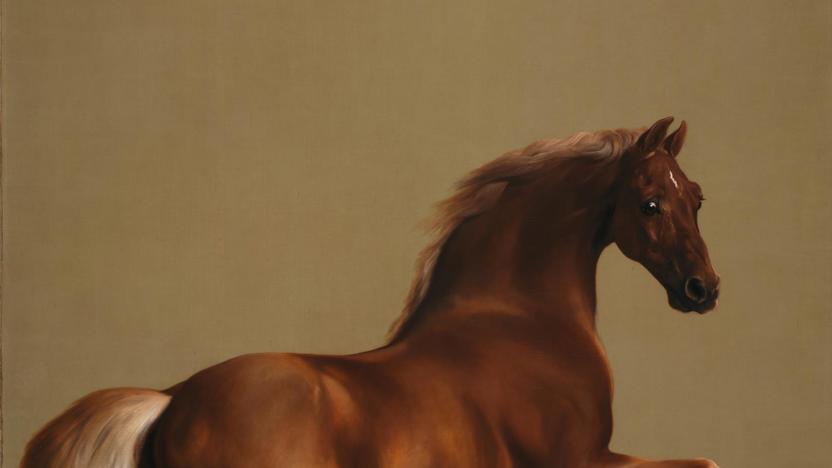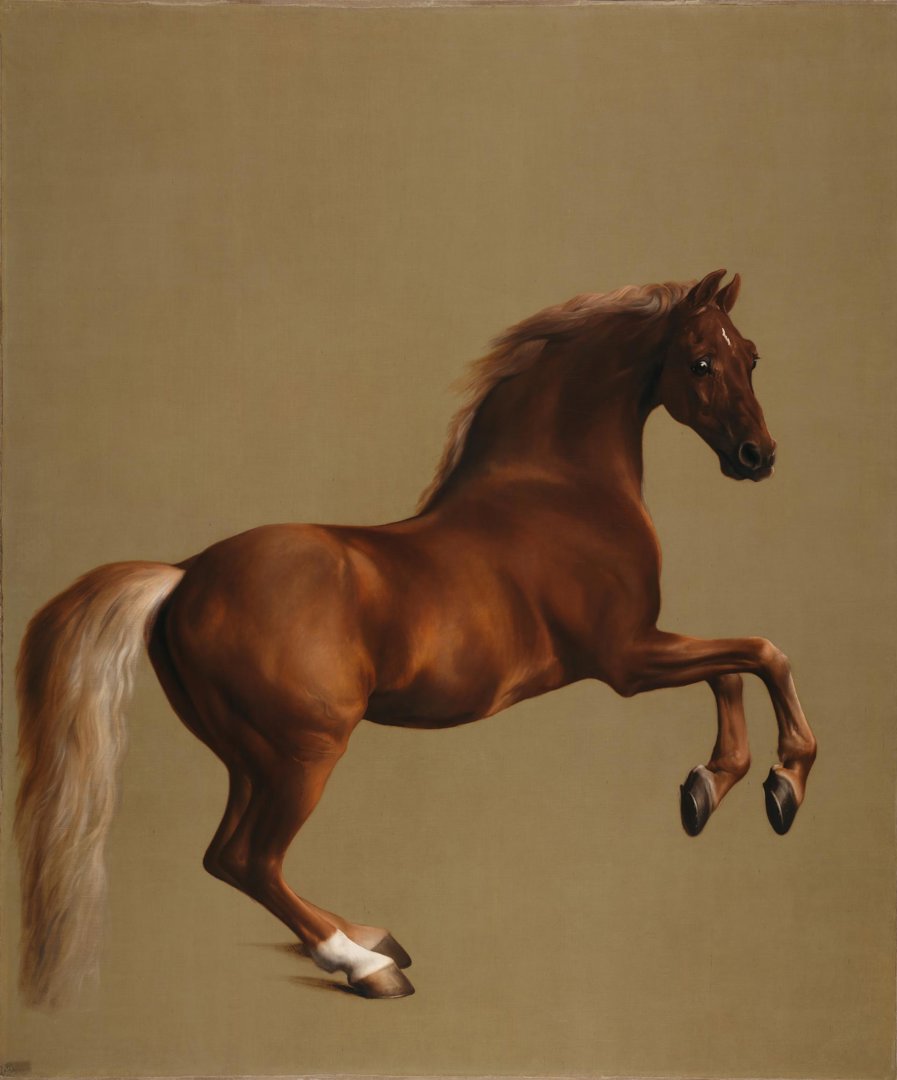George Stubbs's 'Whistlejacket'
Audio description
This is a description of 'Whistlejacket', by the British artist George Stubbs, painted around 1762. It is oil on canvas, nearly 3 metres high by about two and half metres wide, with a thin gilded frame.
This huge painting depicts a life-sized chestnut coloured stallion, rearing up against a neutral buff coloured background. The riderless horse, unfettered by reins or saddle, is presented to us literally as an unbridled free spirit. Painted in profile, his body faces to the right, twisting slightly as he turns his head towards us. Whistlejacket rears up in a levade position, often used in dressage, standing with his weight on his hind legs with his forelegs up off the ground, drawn in towards his body. The strain on his legs is evident in every sinew and muscle which Stubbs precisely depicts.
This is widely acknowledged to be Stubbs’s masterpiece and one of the most famous paintings of a horse ever created, the embodiment of unrestrained natural energy, exuberance, and a perfect specimen of physical health.
A prime example of pure-bred Arabian stock, 'Whistlejacket' exhibits the finest characteristics of the breed. His rich coppery chestnut coat has a shimmering sheen. He received his name from this beautiful colour– a ‘Whistlejacket’ being a mahogany-coloured mixture of treacle and gin used to cure colds.
His tail and mane are a blend of colours from auburn to blond — reputedly the colouring of the original wild horses of Arabia. His tail reaches almost to the floor and is painted in loose, feathery brushstrokes creating a soft effect. We can identify Whistlejacket by his white ‘socks’, markings just above the hooves of his back legs, and the small white patch on his forehead, known as a ‘star’. His head joins his thick neck in a muscular arched curve, tapering down to flaring nostrils on a soft velvety muzzle. He is painted in such a lifelike manner that it is easy to imagine him exhaling warm hay-scented breath. His bulging eyes meet our gaze and the flash of white around the pupils animates them. Alert pricked ears tell us he is aware of our presence and the carefully recorded veins around his eyes and nose make his profile pulsate with life.
In 1762 Stubbs spent several months at Wentworth House, owned by the Marquess of Rockingham, one of the richest men in England. Briefly Prime Minister,
Rockingham’s many passions included collecting classical sculpture, gambling and breeding racehorses. Stubbs completed several paintings of his horses, including Whistlejacket, a previous winner at York.
Stubbs stood out from other equine painters in his thorough understanding of horse anatomy. A few years after painting Whistlejacket, Stubbs spent 18 months dissecting and drawing horse carcasses in a Lincolnshire barn, culminating in the publication of his Anatomy of the Horse in 1766.
The composition of 'Whistlejacket' is likely as much indebted to observations of classical sculpture as to observations of Whistlejacket himself, as a levade could only be held by a horse for a minute or so. The pose, previously used in large heroic equestrian portraits by artists like Rubens and Velázquez, was typically deployed to indicate the majesty or rank of a ruler or military commander in the saddle. Stubbs’ unusual choice to present a riderless horse on a plain background led many writers to speculate that this painting was unfinished. Stories grew that Stubbs planned to add King George III as rider, or employ another artist to paint in a background. We cannot know for sure, but shadows painted under Whistlejacket’s back hooves suggest this is the finished version. The effect creates the feeling of a classical frieze, yet the power of the image lies in Stubb’s ability to both conjure a believable encounter with a living, breathing animal, while at the same time presenting us with an idealised horse for all time.


